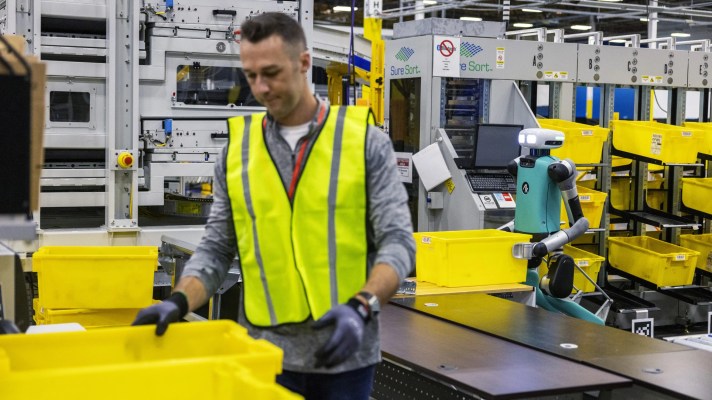Amazon has spent nearly two years putting an undisclosed portion of its $1 billion industrial innovation fund to work with investments in nearly a dozen U.S. and Israeli startups focused on logistics, the supply chain and customer fulfillment. Now, Amazon is flexing a bit — with an aim to expand geographically and to push into areas like generative AI that support the broader mission, the fund’s new head Franziska Bossart told TechCrunch in an exclusive interview.
The Amazon Industrial Innovation Fund, which launched in April 2022, is still intent on finding and investing in startups that can help the e-commerce giant deliver goods faster, while improving the experience of customers as well as the employees who work in its warehouses and logistics departments. The fund is also designed to build off of Amazon’s previous investments in AI and robotics that have led to improvements in its operations, including the addition of robotic arms that perform repetitive tasks and automation vehicles that can help transport larger items. Its first tranche of investments in 2022 went to five startups that are developing robotics and wearable technology that improves safety in its fulfillment centers.
The fund had a slow start with reportedly just $110 million invested into startups in its first year. The pace appears to have picked up since spring 2023 with investments in Veo Robotics, computer vision company Flymingo, industrial wireless automation startup CoreTigo, Rightbot and Instock. The fund even recently invested in an undisclosed generative AI startup, said Bossart, who would only say the company’s technology could have a strong impact on robotics.
“There’s been momentum with the fund, especially at the end of the year, she added.
Now the scope — geographically and thematically — is growing. Bossart told TechCrunch that she sees potential in Europe and Asia and would like the portfolio, which is largely made up of early-stage companies, to shift “a little bit” more toward investments in later-stage startups. The company also posted a blog Wednesday that outlines the fund’s evolution.
Bossart is also homing in on three key areas: AI, gaining momentum in bipedal/humanoid robots and finding startups with technology such as autonomous vehicles that will improve middle-mile and last-mile delivery.
Amazon’s interest in and use of AI isn’t new. However, Bossart sees potential in applying generative AI to robotics and automation. Machine learning, a form of AI in which computer systems learn from data, is already used in robotics. Bossart is looking for startups that are using generative AI, which uses trained models to create new information and data, that can be applied to perception, manipulation and control to improve automation. In other words, using generative AI to help fuse all of the pieces within robotics and automation together to make it more capable.
And she pointed out that it’s an opportunity for startups as well. “A lot of these startups’ biggest challenge is to get access to large datasets,” which are used for training AI, she said. “Amazon has one of the largest datasets around.”
Robotics has long been a key area of interest for Amazon, a company that relies heavily on automation and robotics to meet its delivery targets. Companies developing humanoid robots are of particular interest, Bossart said, pointing to the fund’s investment in Agility Robotics, a Corvallis, Oregon startup best known for its bipedal walking robot named Digit.
Amazon started in October 2023 testing Agility’s robotic system Digit at its BFI1 R&D facility, outside Seattle. But even as Amazon’s relationship with Agility continues, Bossart said there’s still room and interest in investing in other companies working on the technology.
“Mobile manipulation holds a great deal of promise,” Bossart said, noting that the company is particularly interested in how bipedal robots can work collaboratively with humans to improve safety. The company already has evidence that shows how robots can reduce injuries. Amazon collected data that shows recordable incident rates and lost-time incident rates were 15% and 18% lower, respectively, at Amazon Robotics sites than they were at its non-robotics sites in 2022.
Bossart also sees promise in middle- and last-mile solutions to get those packages to customers faster. And that doesn’t just mean investing in startups developing autonomous vehicle technology — although Bossart indicated that is on the list. Bossart is also looking for startups working on technology for all points of the supply chain. For instance, small automation tools that help unload packages faster, she noted.
And while the company is always keen to find startups with technology that can be used within Amazon’s ecosystem, Bossart emphasized that the fund’s investments aren’t tied to commercialization.
“We’re experimental at heart,” Bossart said.
The Amazon Industrial Innovation Fund isn’t the only investment tool in the company’s repertoire. Amazon has a long history of seeking out and backing companies developing new technology, products and services critical to its own mission. Sometimes, Amazon even acquires the company outright.
In 2020, Amazon launched a $2 billion Climate Pledge Fund to invest in sustainable technologies and services that will help the company reach its commitment to be net-zero carbon in its operations by 2040. Amazon’s climate fund has invested in more than a dozen companies to date, including CarbonCure, CMC Machinery, Pachama, Redwood Materials, Resilient Power, Rivian, TurnTide Technologies, BETA Technologies, Ion Energy, ZeroAvia and Infinium.
